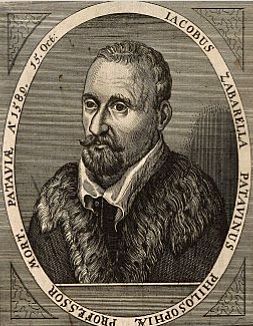359. There and Back Again: Zabarella on Scientific Method
Jacopo Zabarella outlines the correct method for pursuing, and then presenting, scientific discoveries.
Themes:
• J.P. McCaskey (ed. and trans.), Jacopo Zabarella: On Methods, On Regressus, 2 vols (Cambridge MA: 2013).
---
• D. DiLiscia et al. (eds.), Method and Order in Renaissance Philosophy of Nature: the Aristotle Commentary Tradition (Aldershot: 1997).
• N.W. Gilbert, Renaissance Concepts of Method (New York: 1960).
• H. Mikkeli, An Aristotelian Response to Renaissance Humanism: Jacopo Zabarella on the Nature of Arts and Sciences (Helsinki: 1992).
• A. Poppi, La dottrina della Scienza in Giacomo Zabarella (Padua: 1972).
• J.H. Russell, “The Development of Scientific Method in the School of Padua,” Journal of the History of Ideas 1 (1940), 177-206.
• J.H. Randall, The School of Padua and the Emergence of Modern Science (Padua: 1961).
• W.A. Wallace, “Circularity and the Paduan Regressus: from Pietro d’Abano to Galileo Galilei,” Vivarium 33 (1995), 76-97.
Stanford Enyclopedia of Philosophy: Zabarella







Comments
Spatial metaphors for dialectic
Thanks for yet another great episode! Just wanted to ask: where does that metaphor of runners appear in Aristotle? It seems that the underlying dynamic – movement towards general principles; return to specifics with a new perspective on them – is identical with the upward/downward motion of Platonic dialectics, but the athletic metaphor keeps us on one plane, rather than the transcendent ascent in Plato's model. It rather reinforces the classic distinction between them, as portrayed in The School of Athens. Do you think the different spatial arrangement represents a substantial difference between their philosophies?
In reply to Spatial metaphors for dialectic by Henry King
Racetrack metaphor
It appears in Aristotle's Nicomachean Ethics 1.4. Your intuition makes sense but as it turns out Aristotle offers the metaphor as one to illustrate Plato's own point that "it makes all the difference whether one is heading towards the principles or coming from them" (quoting that from memory, might not be quite right). So we may actually think here of the ascent/descent model of dialectic in the Republic and in this metaphor the motion is simply pictured horizontally, but the philosophical point is the same.
In reply to Racetrack metaphor by Peter Adamson
Aha, fascinating—thanks! I…
Aha, fascinating—thanks! I guess now that we have ovoid racetracks, the modern comparison would be Olympic swimmings turning at the end of the pool. A great image for philosophy!
Ovoid racetracks
I was imagining an oval racetrack in my mind during this episode - oops! Thanks for the swimming pool image Henry.
Pauline Kael
To this day, I agree with her opinion on Star Wars. No misjudgment at all.
In reply to Pauline Kael by Harold Augenbraum
Star Wars
For all the philosophy debates, I think this is the most controversial thing ever posted here on the website.
May the Force be with you!
Piccolimini(s)
Dear P. Adamson.
Thanks for this episode. I would like, nevertheless, to point out a detail perhaps you should check.
At minute 16:40 you mentioned that Zabarella's rival in the question of regress was an Alessandro Piccolomini. If I am not wrong, Alessandro Piccolomini (1508-1579) was an earlier philosopher involved in the question of the certainty of mathematics as well as the translation of Aristotelian works into vernacular Italian. He never held a chair at Padua. I think that the Piccolomini you were referring to is Francesco Piccolomini (1523–1607). Since both authors held from Siena and had the same surname, they can be easily confused...
Thanks again.
In reply to Piccolimini(s) by Álvaro Bo
Piccolominis
Oh yes, you might be right about that - pity that you didn't catch this before the book version came out! Funnily enough elsewhere in the book I caution the reader against confusing Francesco Piccolomini with Enea Silvio Piccolomini. I think I am going to put the blame on the Renaissance Italians for all having the same names!
Add new comment